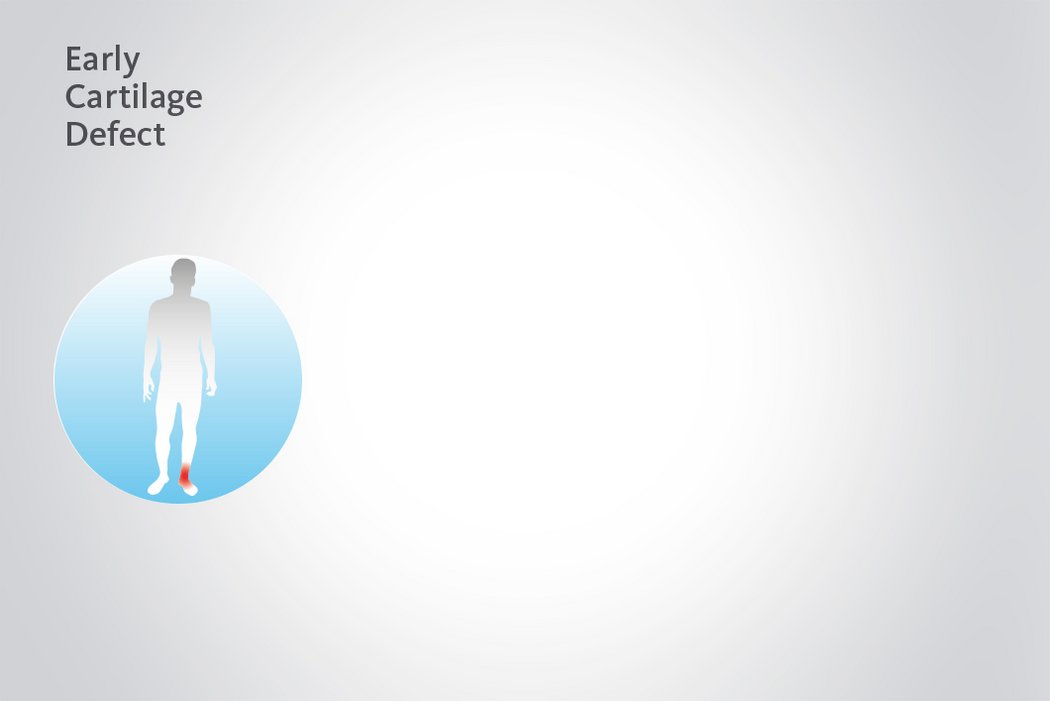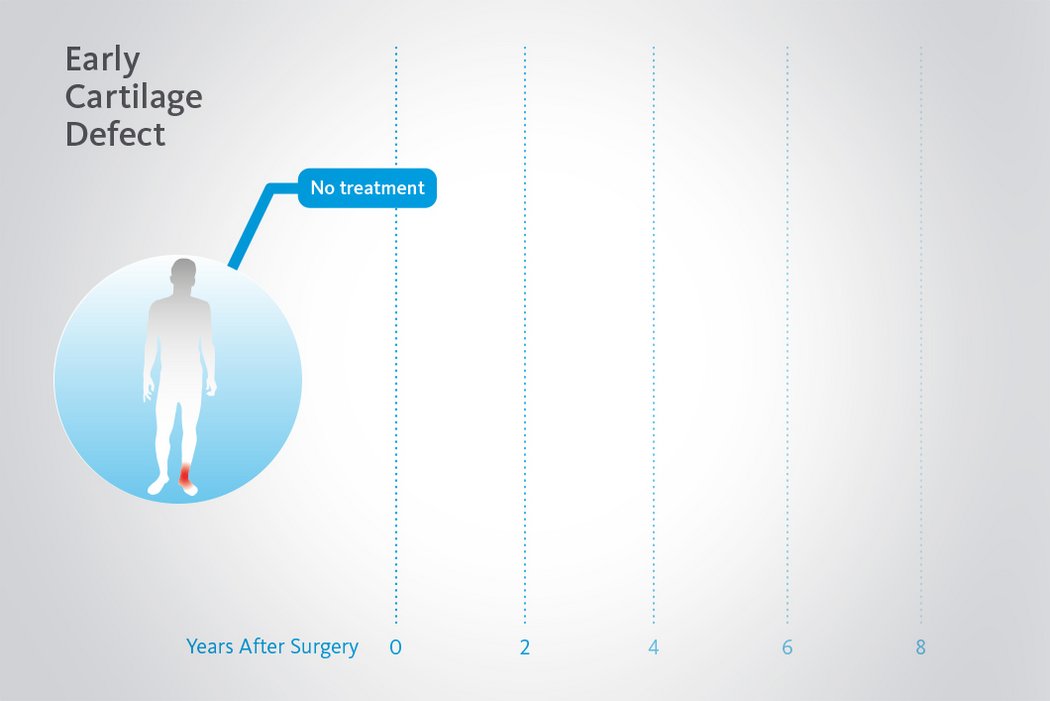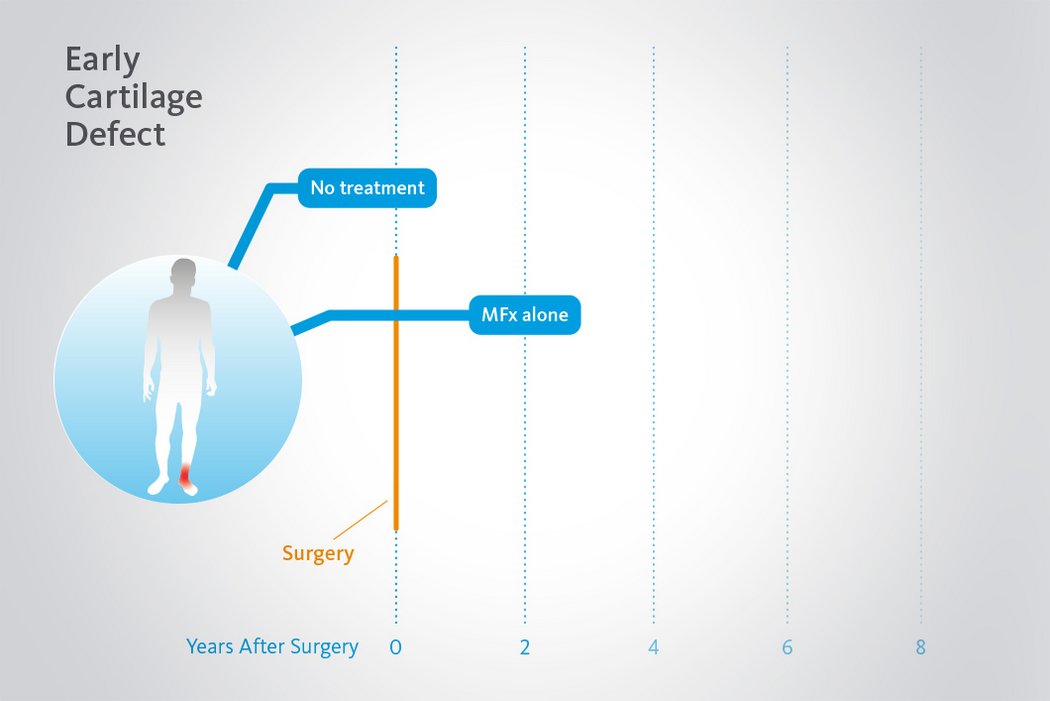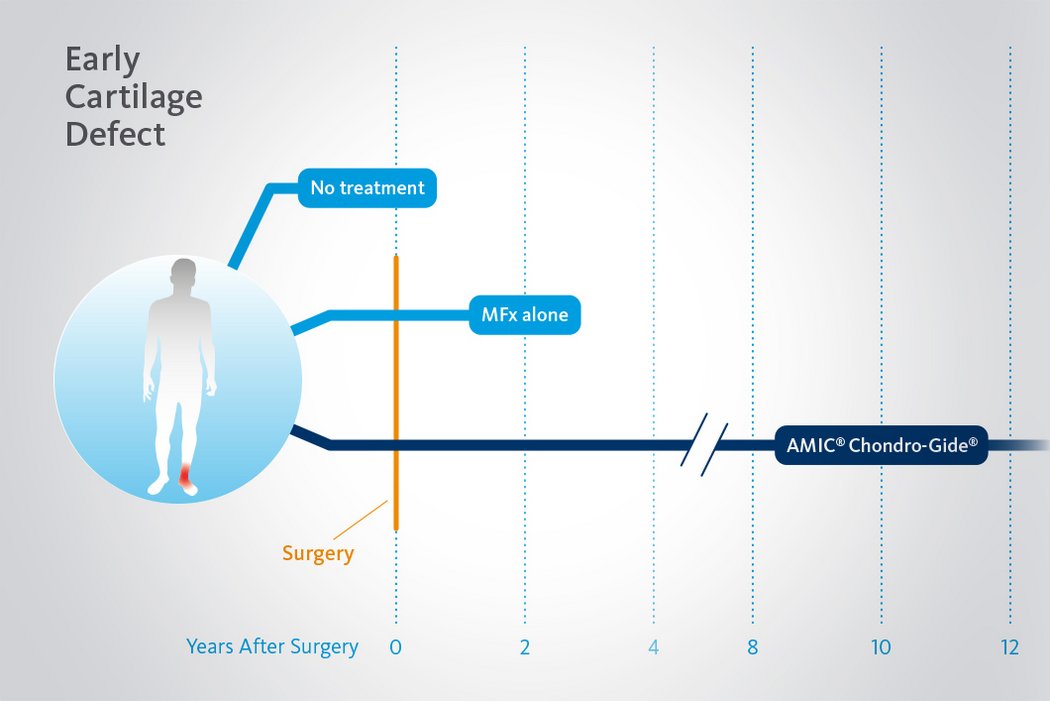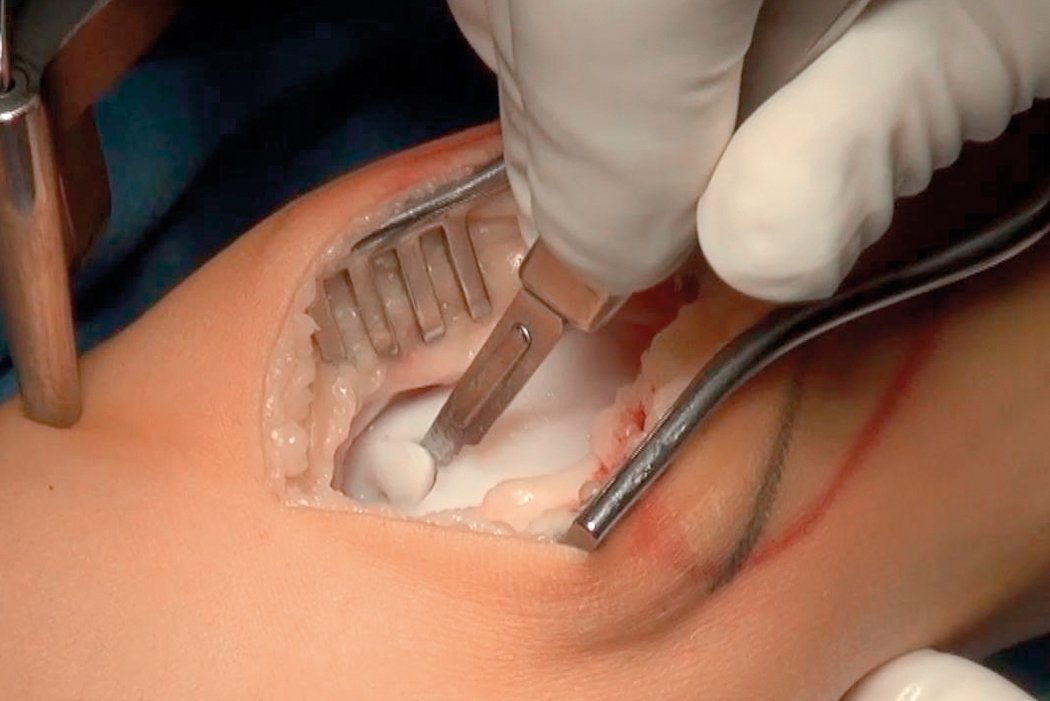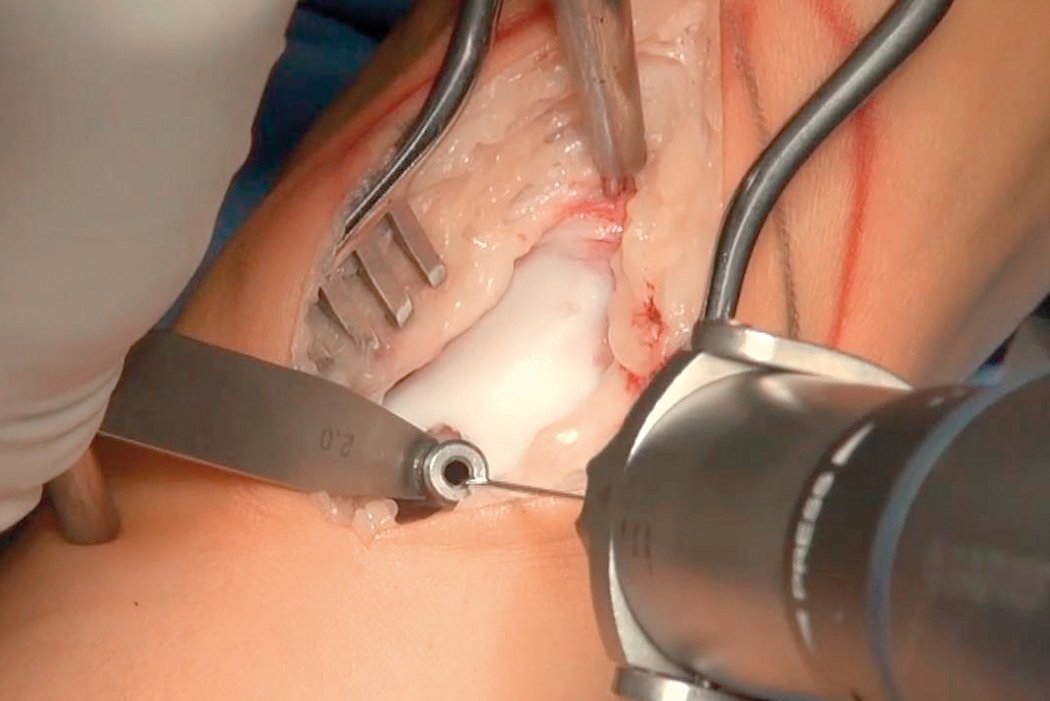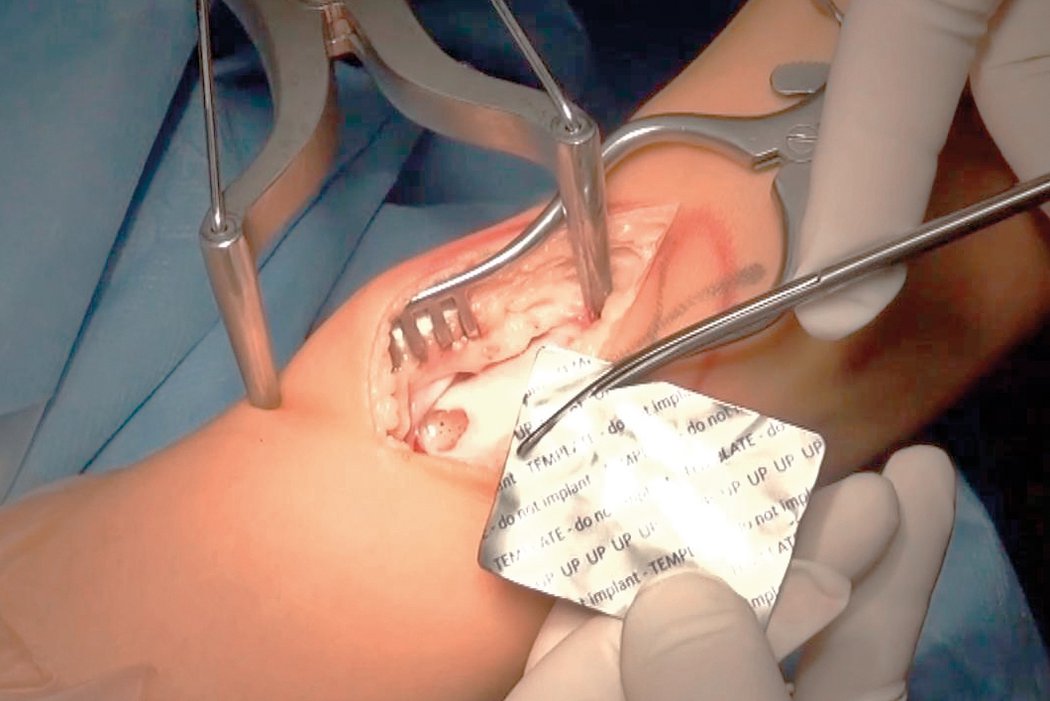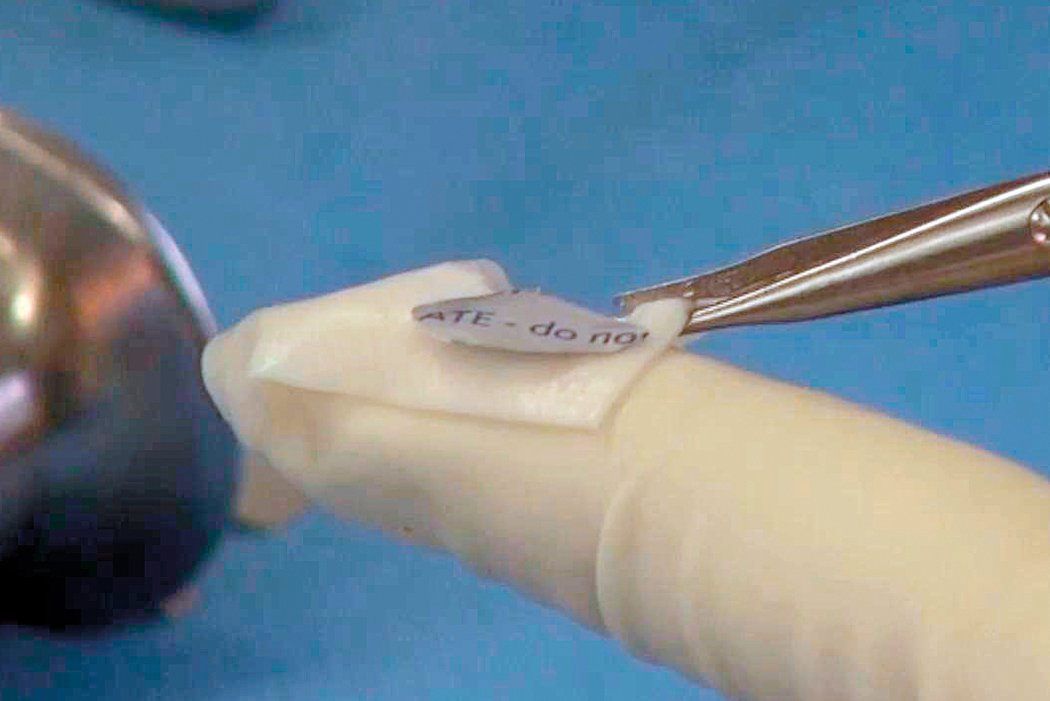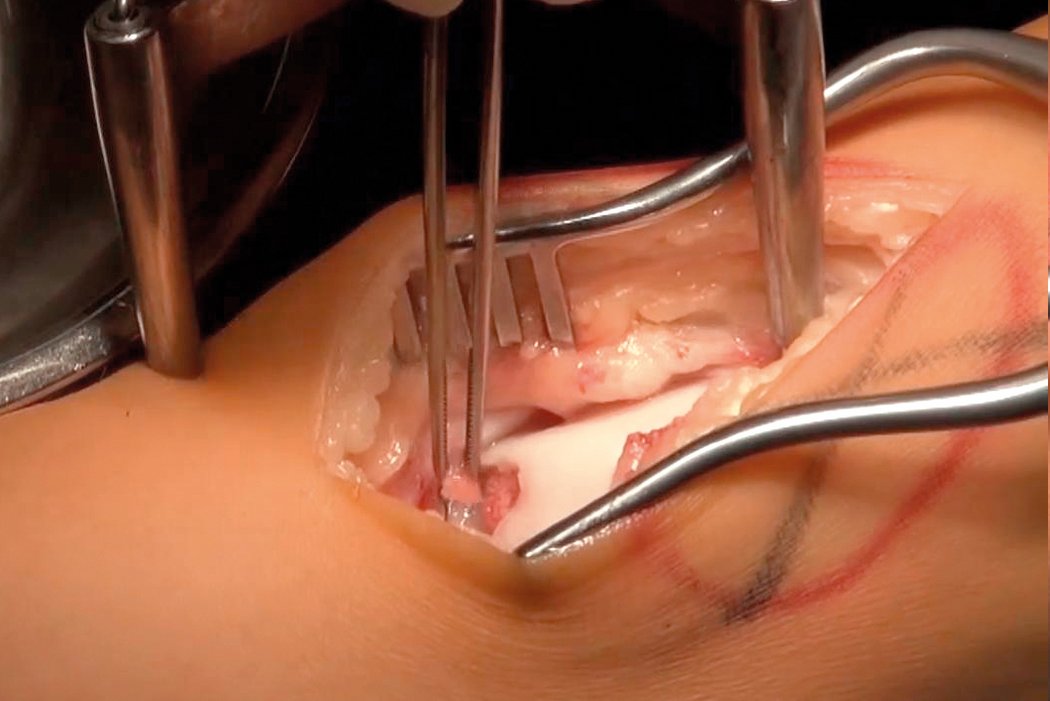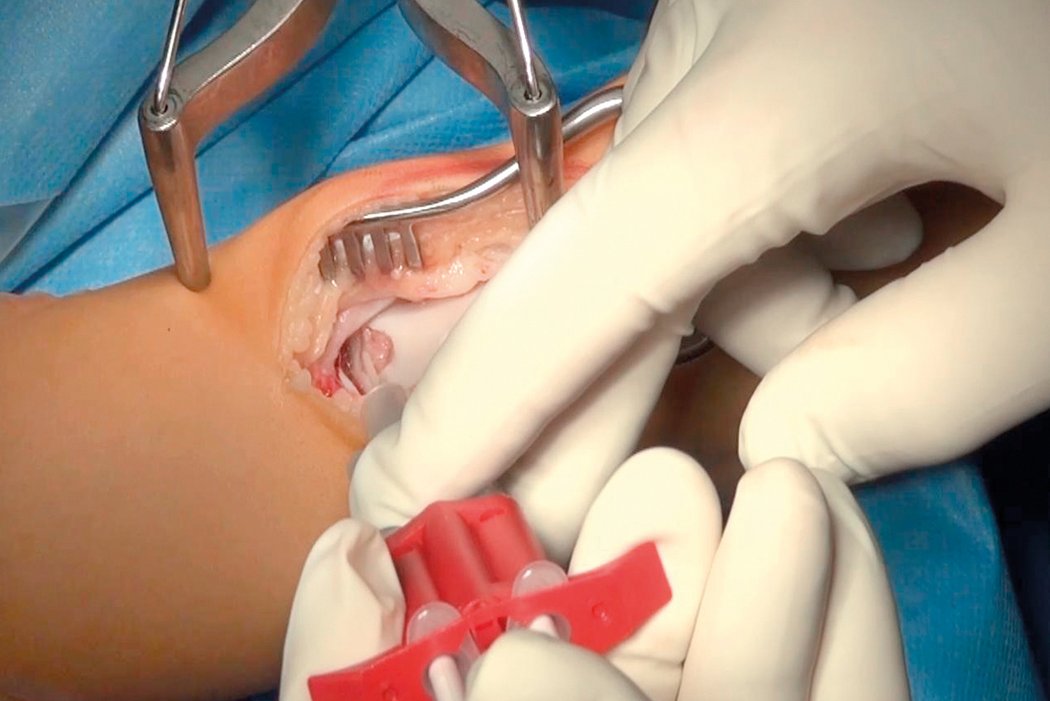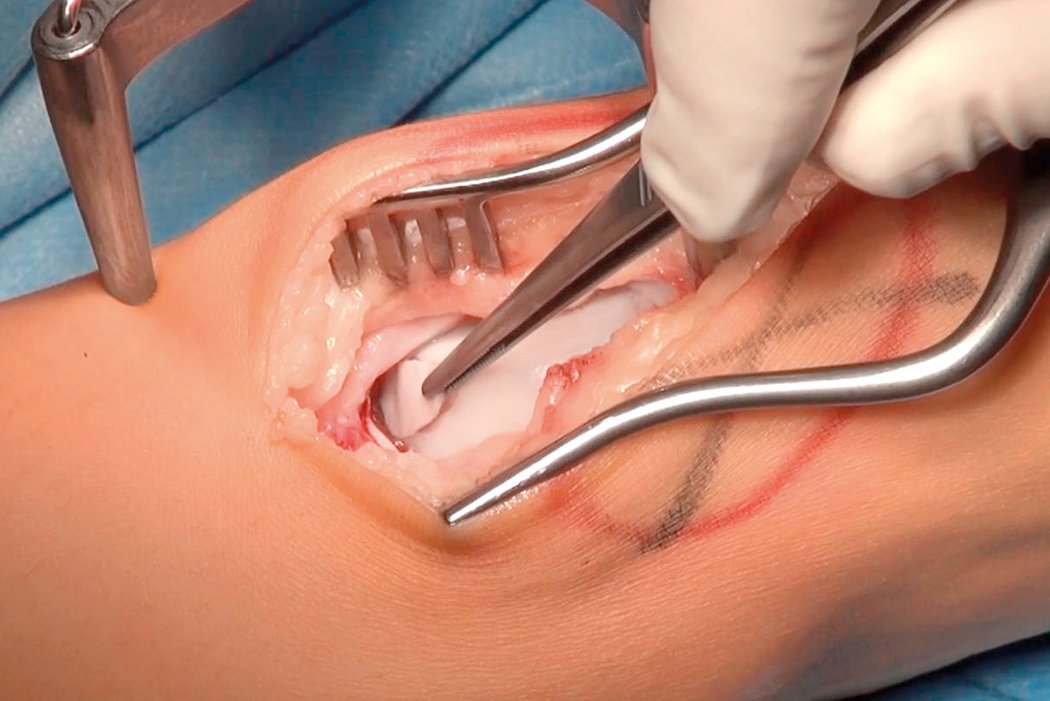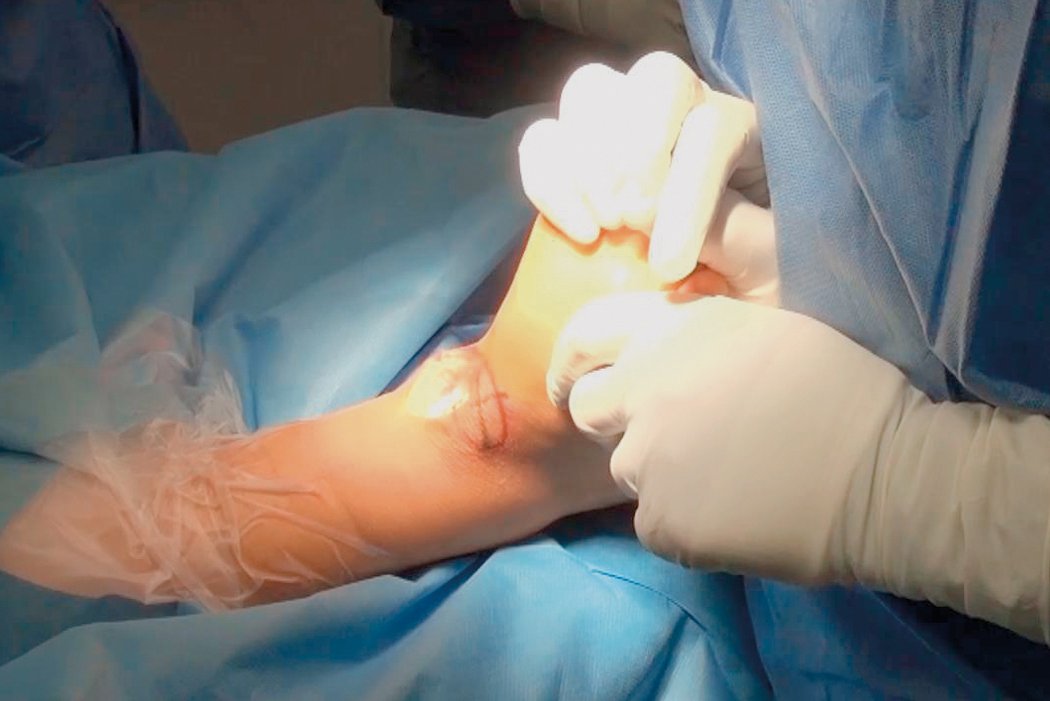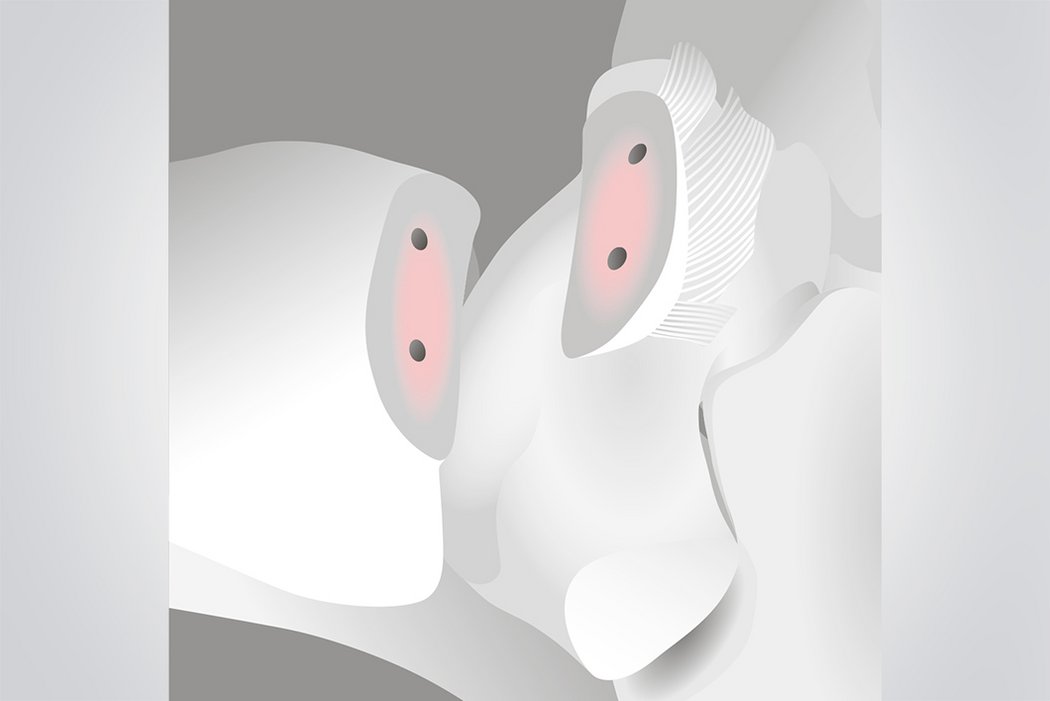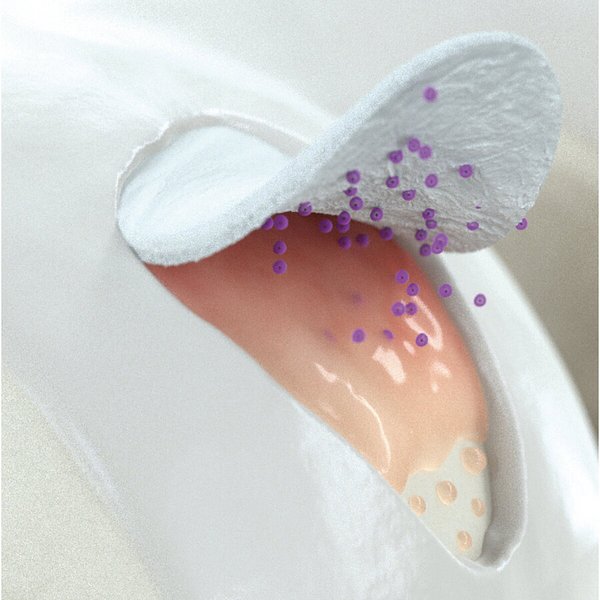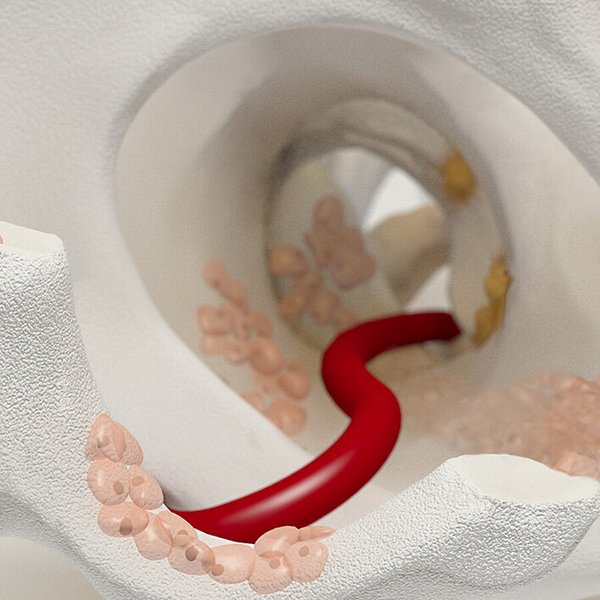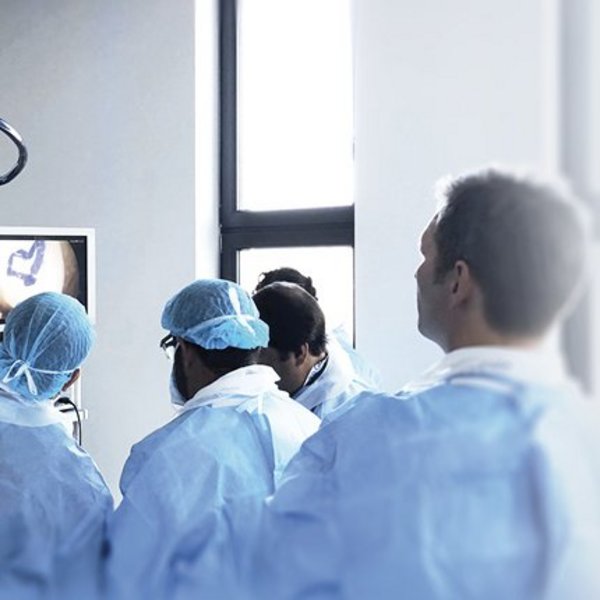AMIC® Chondro-Gide® - Talus

Les lésions chondrales et ostéochondrales (OCL) de la cheville sont fréquentes et sont de plus en plus considérées comme pouvant être la cause de douleurs chroniques à la cheville. La plupart des lésions ostéochondrales du talus (OLT) sont dues aux traumatismes et aux microtraumatismes répétés. Environ 50 % des entorses de la cheville et jusqu’à 73 % des fractures de la cheville sont causées par une blessure au cartilage et peuvent entraîner des symptômes.2
La stimulation de la moelle osseuse est recommandée pour les lésions ostéochondrales < 1 cm2
Ramponi et al. recommandent que les techniques de stimulation de la moelle osseuse soient réservées aux lésions ostéochondrales < 1 cm2. Le seuil de 1 cm2 a également été mentionné lors d’une conférence de consensus de la International Society on Cartilage Repair of the Ankle (ISCRA) en 2017. Pour lire ces déclarations de consensus et en voir d’autres, visiter le site de la fondation ON Foundation.
L’ISCRA a défini une dimension idéale pour la stimulation de la moelle osseuse : le diamètre doit être < 10 mm, la surface doit être < 100 mm2, et la profondeur < 5 mm. La greffe osseuse peut être envisagée pour une profondeur > 3 mm. Les recommandations consensuelles se fondent sur la littérature scientifique actuelle et soutiennent l’utilisation d'un échafaudage en complément de la greffe osseuse.5
AMIC® Chondro-Gide® pour une régénération du cartilage efficace
AMIC® Chondro-Gide® est une méthode en une seule étape mini-invasive qui utilise la stimulation de la moelle osseuse avec Chondro-Gide pour régénérer les lésions du cartilage de toutes dimensions. Elle peut être réalisée par ostéotomie ou par chirurgie en « mini-open ».
Élaborée par Geistlich Surgery avec l’aide d’éminents chirurgiens européens, AMIC® Chondro-Gide® est un traitement efficace et économique permettant de régénérer le cartilage endommagé, d’atténuer ou de prévenir la douleur, et de ralentir la progression de la lésion.
Références
- CHEW, K. T. L., 2008, Osteochondral lesions of the talus. Annals of the Academy of Medicine. 2008. Vol.37, no. 1, p. 63-8
- STEELE, J. R., et al., Osteochondral Lesions of the Talus. Foot & Ankle Orthopaedics. 2018. Vol. 3, no. 3, p. 247301141877955. DOI 10.1177/2473011418779559. SAGE Publications
- RAMPONI, L., et al., Lesion Size Is a Predictor of Clinical Outcomes After Bone Marrow Stimulation for Osteochondral Lesions of the Talus: A Systematic Review. The American Journal of Sports Medicine. 2016. Vol. 45, no. 7, p. 1698-1705. DOI10.1177/0363546516668292. SAGE Publications (Systematic Review)
- HANNON et al. Debridement, Curettage, Microfracture, and Fixation Techniques for Osteochondral Lesions of the Talus, 2018. Foot & Ankle Orthopaedics, Vol. 3, no. 3, p. 2473011418S0006. DOI 10.1177/2473011418s00066. SAGE Publications (Consensus Meeting Report)
- ROTHRAUFF, B.B., et al., Scaffold-Based Therapies: Proceedings of the International Consensus Meeting on Cartilage Repair of the Ankle. Foot & Ankle International. 2018. Vol. 39, no. 1_suppl, p. 41S-47S. DOI 10.1177/1071100718781864. SAGE Publications (Consensus Meeting)24. WALTHER, M., ALTENBERGER, S., KRIEGELSTEIN, S., VOLKERING, C. and R.SER, A., 2014, Reconstruction of focal cartilage defects in the talus with miniarthrotomy and collagen matrix. Operative Orthop.die und Traumatologie. 2014. Vol. 26, no. 6, p. 603-610. DOI 10.1007/s00064-012-0229-9. Springer Nature (Clinical Study)
- VALDERRABANO, V., et al., Reconstruction of Osteochondral Lesions of the Talus With Autologous Spongiosa Grafts and Autologous Matrix-Induced Chondrogenesis. The American Journal of Sports Medicine. 2013. Vol. 41, no. 3, p. 519-527.DOI 10.1177/0363546513476671. SAGE Publications (Clinical Study)
- WALTHER, M., et al., Reconstruction of focal cartilage defects in the talus with miniarthrotomy and collagen matrix. Operative Orthop.die und Traumatologie. 2014. Vol. 26, no. 6, p. 603-610. DOI 10.1007/s00064-012-0229-9. Springer Nature (Clinical Study)
- GOTTSCHALK, O., et al., Functional Medium-Term Results After Autologous Matrix-Induced Chondrogenesis for Osteochondral Lesions of the Talus: A 5-Year Prospective Cohort Study. The Journalof Foot and Ankle Surgery. 2017. Vol. 56, no. 5, p. 930-936. DOI 10.1053/j.jfas.2017.05.002. Elsevier BV (Clinical Study)
- YOUNG, KI WON, et al., Medial approaches to osteochondral lesion of the talus without medial malleolar osteotomy. Knee Surgery, Sports Traumatology, Arthroscopy. 2009. Vol. 18, no. 5, p. 634-637. DOI 10.1007/s00167-009-1019-2. Springer Nature
- GALLA, MELLANY, DUENSING, IAN, KAHN, TIMOTHY L. and BARG, ALEXEJ, 2018, Open reconstruction with autologous spongiosa grafts and matrix-induced chondrogenesis for osteochondral lesions of the talus can be performed without medial malleolar osteotomy. Knee Surgery, Sports Traumatology, Arthroscopy. 2018. DOI 10.1007/s00167-018-5063-7. Springer Nature (Clinical Study)
- Chondro-Gide® IFU 2019, Geistlich Pharma AG
- WALTHER, M., et al., Reconstruction of focal cartilage defects in the talus with miniarthrotomy and collagen matrix. Operative Orthopädie und Traumatologie. 2014. Vol. 26, no. 6, p. 603-610. DOI 10.1007/s00064-012-0229-9. Springer Nature (Clinical Study)
- GOTTSCHALK, O., et al., Functional Medium-Term Results After Autologous Matrix-Induced Chondrogenesis for Osteochondral Lesions of the Talus: A 5-Year Prospective Cohort Study. The Journal of Foot and Ankle Surgery. 2017. Vol. 56, no. 5, p. 930-936. DOI 10.1053/j.jfas.2017.05.002. Elsevier BV (Clinical Study)
- USUELLI, F., et al., All-arthroscopic AMIC® (AT-AMIC®) technique with autologous bone graft for talar osteochondral defects: clinical and radiological results. Knee Surgery, Sports Traumatology, Arthroscopy. 2016. Vol. 26, no. 3, p. 875-881. DOI 10.1007/s00167-016-4318-4. Springer Nature (Clinical Study)
Références
- CHEW, K. T. L., 2008, Osteochondral lesions of the talus. Annals of the Academy of Medicine. 2008. Vol.37, no. 1, p. 63-8
- STEELE, J. R., et al., Osteochondral Lesions of the Talus. Foot & Ankle Orthopaedics. 2018. Vol. 3, no. 3, p. 247301141877955. DOI 10.1177/2473011418779559. SAGE Publications
- RAMPONI, L., et al., Lesion Size Is a Predictor of Clinical Outcomes After Bone Marrow Stimulation for Osteochondral Lesions of the Talus: A Systematic Review. The American Journal of Sports Medicine. 2016. Vol. 45, no. 7, p. 1698-1705. DOI10.1177/0363546516668292. SAGE Publications (Systematic Review)
- HANNON et al. Debridement, Curettage, Microfracture, and Fixation Techniques for Osteochondral Lesions of the Talus, 2018. Foot & Ankle Orthopaedics, Vol. 3, no. 3, p. 2473011418S0006. DOI 10.1177/2473011418s00066. SAGE Publications (Consensus Meeting Report)
- ROTHRAUFF, B.B., et al., Scaffold-Based Therapies: Proceedings of the International Consensus Meeting on Cartilage Repair of the Ankle. Foot & Ankle International. 2018. Vol. 39, no. 1_suppl, p. 41S-47S. DOI 10.1177/1071100718781864. SAGE Publications (Consensus Meeting)24. WALTHER, M., ALTENBERGER, S., KRIEGELSTEIN, S., VOLKERING, C. and R.SER, A., 2014, Reconstruction of focal cartilage defects in the talus with miniarthrotomy and collagen matrix. Operative Orthop.die und Traumatologie. 2014. Vol. 26, no. 6, p. 603-610. DOI 10.1007/s00064-012-0229-9. Springer Nature (Clinical Study)
- VALDERRABANO, V., et al., Reconstruction of Osteochondral Lesions of the Talus With Autologous Spongiosa Grafts and Autologous Matrix-Induced Chondrogenesis. The American Journal of Sports Medicine. 2013. Vol. 41, no. 3, p. 519-527.DOI 10.1177/0363546513476671. SAGE Publications (Clinical Study)
- WALTHER, M., et al., Reconstruction of focal cartilage defects in the talus with miniarthrotomy and collagen matrix. Operative Orthop.die und Traumatologie. 2014. Vol. 26, no. 6, p. 603-610. DOI 10.1007/s00064-012-0229-9. Springer Nature (Clinical Study)
- GOTTSCHALK, O., et al., Functional Medium-Term Results After Autologous Matrix-Induced Chondrogenesis for Osteochondral Lesions of the Talus: A 5-Year Prospective Cohort Study. The Journalof Foot and Ankle Surgery. 2017. Vol. 56, no. 5, p. 930-936. DOI 10.1053/j.jfas.2017.05.002. Elsevier BV (Clinical Study)
- YOUNG, KI WON, et al., Medial approaches to osteochondral lesion of the talus without medial malleolar osteotomy. Knee Surgery, Sports Traumatology, Arthroscopy. 2009. Vol. 18, no. 5, p. 634-637. DOI 10.1007/s00167-009-1019-2. Springer Nature
- GALLA, MELLANY, DUENSING, IAN, KAHN, TIMOTHY L. and BARG, ALEXEJ, 2018, Open reconstruction with autologous spongiosa grafts and matrix-induced chondrogenesis for osteochondral lesions of the talus can be performed without medial malleolar osteotomy. Knee Surgery, Sports Traumatology, Arthroscopy. 2018. DOI 10.1007/s00167-018-5063-7. Springer Nature (Clinical Study)
- Chondro-Gide® IFU 2019, Geistlich Pharma AG
- WALTHER, M., et al., Reconstruction of focal cartilage defects in the talus with miniarthrotomy and collagen matrix. Operative Orthopädie und Traumatologie. 2014. Vol. 26, no. 6, p. 603-610. DOI 10.1007/s00064-012-0229-9. Springer Nature (Clinical Study)
- GOTTSCHALK, O., et al., Functional Medium-Term Results After Autologous Matrix-Induced Chondrogenesis for Osteochondral Lesions of the Talus: A 5-Year Prospective Cohort Study. The Journal of Foot and Ankle Surgery. 2017. Vol. 56, no. 5, p. 930-936. DOI 10.1053/j.jfas.2017.05.002. Elsevier BV (Clinical Study)
- USUELLI, F., et al., All-arthroscopic AMIC® (AT-AMIC®) technique with autologous bone graft for talar osteochondral defects: clinical and radiological results. Knee Surgery, Sports Traumatology, Arthroscopy. 2016. Vol. 26, no. 3, p. 875-881. DOI 10.1007/s00167-016-4318-4. Springer Nature (Clinical Study)
Références
- CHEW, K. T. L., 2008, Osteochondral lesions of the talus. Annals of the Academy of Medicine. 2008. Vol.37, no. 1, p. 63-8
- STEELE, J. R., et al., Osteochondral Lesions of the Talus. Foot & Ankle Orthopaedics. 2018. Vol. 3, no. 3, p. 247301141877955. DOI 10.1177/2473011418779559. SAGE Publications
- RAMPONI, L., et al., Lesion Size Is a Predictor of Clinical Outcomes After Bone Marrow Stimulation for Osteochondral Lesions of the Talus: A Systematic Review. The American Journal of Sports Medicine. 2016. Vol. 45, no. 7, p. 1698-1705. DOI10.1177/0363546516668292. SAGE Publications (Systematic Review)
- HANNON et al. Debridement, Curettage, Microfracture, and Fixation Techniques for Osteochondral Lesions of the Talus, 2018. Foot & Ankle Orthopaedics, Vol. 3, no. 3, p. 2473011418S0006. DOI 10.1177/2473011418s00066. SAGE Publications (Consensus Meeting Report)
- ROTHRAUFF, B.B., et al., Scaffold-Based Therapies: Proceedings of the International Consensus Meeting on Cartilage Repair of the Ankle. Foot & Ankle International. 2018. Vol. 39, no. 1_suppl, p. 41S-47S. DOI 10.1177/1071100718781864. SAGE Publications (Consensus Meeting)24. WALTHER, M., ALTENBERGER, S., KRIEGELSTEIN, S., VOLKERING, C. and R.SER, A., 2014, Reconstruction of focal cartilage defects in the talus with miniarthrotomy and collagen matrix. Operative Orthop.die und Traumatologie. 2014. Vol. 26, no. 6, p. 603-610. DOI 10.1007/s00064-012-0229-9. Springer Nature (Clinical Study)
- VALDERRABANO, V., et al., Reconstruction of Osteochondral Lesions of the Talus With Autologous Spongiosa Grafts and Autologous Matrix-Induced Chondrogenesis. The American Journal of Sports Medicine. 2013. Vol. 41, no. 3, p. 519-527.DOI 10.1177/0363546513476671. SAGE Publications (Clinical Study)
- WALTHER, M., et al., Reconstruction of focal cartilage defects in the talus with miniarthrotomy and collagen matrix. Operative Orthop.die und Traumatologie. 2014. Vol. 26, no. 6, p. 603-610. DOI 10.1007/s00064-012-0229-9. Springer Nature (Clinical Study)
- GOTTSCHALK, O., et al., Functional Medium-Term Results After Autologous Matrix-Induced Chondrogenesis for Osteochondral Lesions of the Talus: A 5-Year Prospective Cohort Study. The Journalof Foot and Ankle Surgery. 2017. Vol. 56, no. 5, p. 930-936. DOI 10.1053/j.jfas.2017.05.002. Elsevier BV (Clinical Study)
- YOUNG, KI WON, et al., Medial approaches to osteochondral lesion of the talus without medial malleolar osteotomy. Knee Surgery, Sports Traumatology, Arthroscopy. 2009. Vol. 18, no. 5, p. 634-637. DOI 10.1007/s00167-009-1019-2. Springer Nature
- GALLA, MELLANY, DUENSING, IAN, KAHN, TIMOTHY L. and BARG, ALEXEJ, 2018, Open reconstruction with autologous spongiosa grafts and matrix-induced chondrogenesis for osteochondral lesions of the talus can be performed without medial malleolar osteotomy. Knee Surgery, Sports Traumatology, Arthroscopy. 2018. DOI 10.1007/s00167-018-5063-7. Springer Nature (Clinical Study)
- Chondro-Gide® IFU 2019, Geistlich Pharma AG
- WALTHER, M., et al., Reconstruction of focal cartilage defects in the talus with miniarthrotomy and collagen matrix. Operative Orthopädie und Traumatologie. 2014. Vol. 26, no. 6, p. 603-610. DOI 10.1007/s00064-012-0229-9. Springer Nature (Clinical Study)
- GOTTSCHALK, O., et al., Functional Medium-Term Results After Autologous Matrix-Induced Chondrogenesis for Osteochondral Lesions of the Talus: A 5-Year Prospective Cohort Study. The Journal of Foot and Ankle Surgery. 2017. Vol. 56, no. 5, p. 930-936. DOI 10.1053/j.jfas.2017.05.002. Elsevier BV (Clinical Study)
- USUELLI, F., et al., All-arthroscopic AMIC® (AT-AMIC®) technique with autologous bone graft for talar osteochondral defects: clinical and radiological results. Knee Surgery, Sports Traumatology, Arthroscopy. 2016. Vol. 26, no. 3, p. 875-881. DOI 10.1007/s00167-016-4318-4. Springer Nature (Clinical Study)
Évidence clinique – AMIC® Chondro-Gide® au Talus
Fonctionnement de Chondro-Gide®
Chondro-Gide® forme un revêtement protecteur et permet de stabiliser les cellules libérées par l’os ou appliquées sur une lésion. La matrice Chondro-Gide® complète les méthodes de traitement régénératif des lésions chondrales et ostéochondrales. Lors des premières étapes du processus de régénération, Chondro-Gide® recouvre la lésion et les cellules qui se trouvent dans la lésion. Puis, après environ 4 mois, il se résorbe et est remplacé par du tissu endogène.
L’efficacité de Chondro-Gide® sans ostéotomie
Plusieurs études ont démontré que Chondro-Gide® peut être appliqué de manière efficace sans avoir à pratiquer d’ostéotomie. Walther et al. ont décrit la reconstruction de lésions focales du cartilage dans le talus par mini-arthrotomie associée à Chondro-Gide, pour le traitement de lésions focales du cartilage d'une dimension > 1,5 cm2 et de grade III et IV (classification ICRS). Les chercheurs ont étudié les résultats postopératoires obtenus pour 14 patients qu’ils ont suivis sur une période de 30 mois minimum. Tous les résultats montraient une amélioration de 50 à 89 points des scores (cotation de l’American Orthopedic Foot and Ankle Society - AOFAS), et l’obtention d'une mobilité équivalente pour les deux articulations des chevilles. Ils n’ont observé aucune complication peropératoire. Ils ont conclu que la technique AMIC® avec Chondro-Gide® est une procédure simple. Dans presque tous les cas, la membrane peut être implantée par simple mini-arthrotomie, sans avoir recours à une ostéotomie de la malléole latérale ou médiale. Ils ont également estimé que AMIC® Chondro-Gide® était une procédure en une seule étape économique par rapport à la réparation cartilagineuse au moyen de chondrocytes cultivés in vitro.
Concernant le moyen terme, Gottschalk et al. ont trouvé des résultats prometteurs lors de l’analyse d’études sur 2 et 5 ans de la cohorte de patients. Les chercheurs ont constaté que la plus grande amélioration des résultats cliniques avait lieu lors de la première année après l’intervention. Ensuite, de la fin de la première année à la cinquième année du suivi, des améliorations statistiquement non significatives ont été observées. De façon significative, les patients reprenaient leur activité sportive après 5 ans.
Références
- CHEW, K. T. L., 2008, Osteochondral lesions of the talus. Annals of the Academy of Medicine. 2008. Vol.37, no. 1, p. 63-8
- STEELE, J. R., et al., Osteochondral Lesions of the Talus. Foot & Ankle Orthopaedics. 2018. Vol. 3, no. 3, p. 247301141877955. DOI 10.1177/2473011418779559. SAGE Publications
- RAMPONI, L., et al., Lesion Size Is a Predictor of Clinical Outcomes After Bone Marrow Stimulation for Osteochondral Lesions of the Talus: A Systematic Review. The American Journal of Sports Medicine. 2016. Vol. 45, no. 7, p. 1698-1705. DOI10.1177/0363546516668292. SAGE Publications (Systematic Review)
- HANNON et al. Debridement, Curettage, Microfracture, and Fixation Techniques for Osteochondral Lesions of the Talus, 2018. Foot & Ankle Orthopaedics, Vol. 3, no. 3, p. 2473011418S0006. DOI 10.1177/2473011418s00066. SAGE Publications (Consensus Meeting Report)
- ROTHRAUFF, B.B., et al., Scaffold-Based Therapies: Proceedings of the International Consensus Meeting on Cartilage Repair of the Ankle. Foot & Ankle International. 2018. Vol. 39, no. 1_suppl, p. 41S-47S. DOI 10.1177/1071100718781864. SAGE Publications (Consensus Meeting)24. WALTHER, M., ALTENBERGER, S., KRIEGELSTEIN, S., VOLKERING, C. and R.SER, A., 2014, Reconstruction of focal cartilage defects in the talus with miniarthrotomy and collagen matrix. Operative Orthop.die und Traumatologie. 2014. Vol. 26, no. 6, p. 603-610. DOI 10.1007/s00064-012-0229-9. Springer Nature (Clinical Study)
- VALDERRABANO, V., et al., Reconstruction of Osteochondral Lesions of the Talus With Autologous Spongiosa Grafts and Autologous Matrix-Induced Chondrogenesis. The American Journal of Sports Medicine. 2013. Vol. 41, no. 3, p. 519-527.DOI 10.1177/0363546513476671. SAGE Publications (Clinical Study)
- WALTHER, M., et al., Reconstruction of focal cartilage defects in the talus with miniarthrotomy and collagen matrix. Operative Orthop.die und Traumatologie. 2014. Vol. 26, no. 6, p. 603-610. DOI 10.1007/s00064-012-0229-9. Springer Nature (Clinical Study)
- GOTTSCHALK, O., et al., Functional Medium-Term Results After Autologous Matrix-Induced Chondrogenesis for Osteochondral Lesions of the Talus: A 5-Year Prospective Cohort Study. The Journalof Foot and Ankle Surgery. 2017. Vol. 56, no. 5, p. 930-936. DOI 10.1053/j.jfas.2017.05.002. Elsevier BV (Clinical Study)
- YOUNG, KI WON, et al., Medial approaches to osteochondral lesion of the talus without medial malleolar osteotomy. Knee Surgery, Sports Traumatology, Arthroscopy. 2009. Vol. 18, no. 5, p. 634-637. DOI 10.1007/s00167-009-1019-2. Springer Nature
- GALLA, MELLANY, DUENSING, IAN, KAHN, TIMOTHY L. and BARG, ALEXEJ, 2018, Open reconstruction with autologous spongiosa grafts and matrix-induced chondrogenesis for osteochondral lesions of the talus can be performed without medial malleolar osteotomy. Knee Surgery, Sports Traumatology, Arthroscopy. 2018. DOI 10.1007/s00167-018-5063-7. Springer Nature (Clinical Study)
- Chondro-Gide® IFU 2019, Geistlich Pharma AG
- WALTHER, M., et al., Reconstruction of focal cartilage defects in the talus with miniarthrotomy and collagen matrix. Operative Orthopädie und Traumatologie. 2014. Vol. 26, no. 6, p. 603-610. DOI 10.1007/s00064-012-0229-9. Springer Nature (Clinical Study)
- GOTTSCHALK, O., et al., Functional Medium-Term Results After Autologous Matrix-Induced Chondrogenesis for Osteochondral Lesions of the Talus: A 5-Year Prospective Cohort Study. The Journal of Foot and Ankle Surgery. 2017. Vol. 56, no. 5, p. 930-936. DOI 10.1053/j.jfas.2017.05.002. Elsevier BV (Clinical Study)
- USUELLI, F., et al., All-arthroscopic AMIC® (AT-AMIC®) technique with autologous bone graft for talar osteochondral defects: clinical and radiological results. Knee Surgery, Sports Traumatology, Arthroscopy. 2016. Vol. 26, no. 3, p. 875-881. DOI 10.1007/s00167-016-4318-4. Springer Nature (Clinical Study)
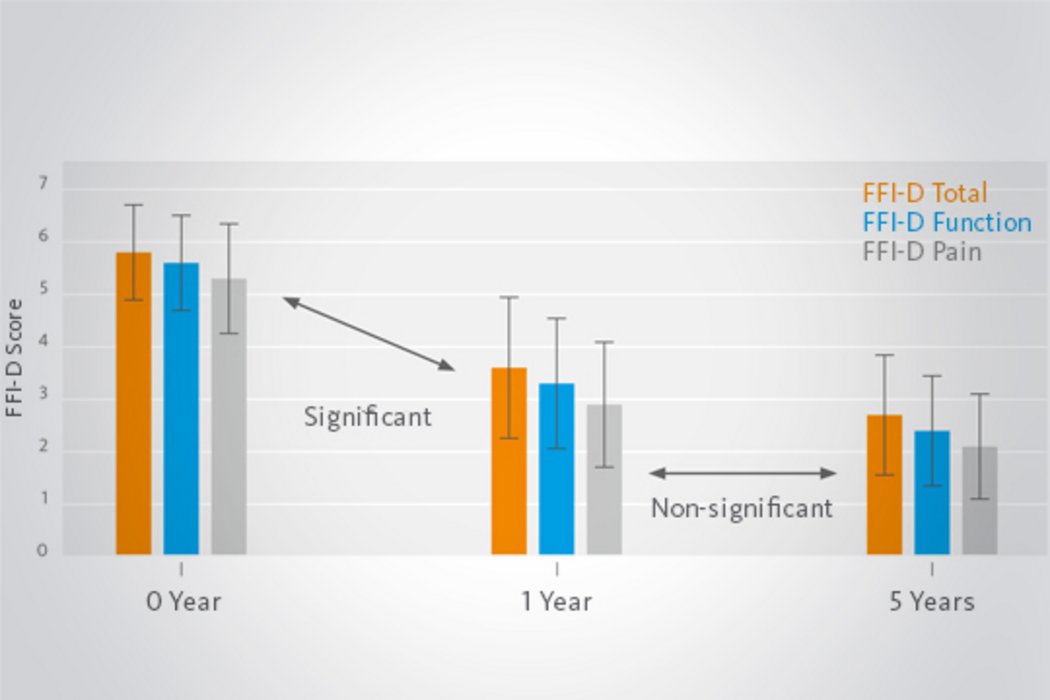
Références
- CHEW, K. T. L., 2008, Osteochondral lesions of the talus. Annals of the Academy of Medicine. 2008. Vol.37, no. 1, p. 63-8
- STEELE, J. R., et al., Osteochondral Lesions of the Talus. Foot & Ankle Orthopaedics. 2018. Vol. 3, no. 3, p. 247301141877955. DOI 10.1177/2473011418779559. SAGE Publications
- RAMPONI, L., et al., Lesion Size Is a Predictor of Clinical Outcomes After Bone Marrow Stimulation for Osteochondral Lesions of the Talus: A Systematic Review. The American Journal of Sports Medicine. 2016. Vol. 45, no. 7, p. 1698-1705. DOI10.1177/0363546516668292. SAGE Publications (Systematic Review)
- HANNON et al. Debridement, Curettage, Microfracture, and Fixation Techniques for Osteochondral Lesions of the Talus, 2018. Foot & Ankle Orthopaedics, Vol. 3, no. 3, p. 2473011418S0006. DOI 10.1177/2473011418s00066. SAGE Publications (Consensus Meeting Report)
- ROTHRAUFF, B.B., et al., Scaffold-Based Therapies: Proceedings of the International Consensus Meeting on Cartilage Repair of the Ankle. Foot & Ankle International. 2018. Vol. 39, no. 1_suppl, p. 41S-47S. DOI 10.1177/1071100718781864. SAGE Publications (Consensus Meeting)24. WALTHER, M., ALTENBERGER, S., KRIEGELSTEIN, S., VOLKERING, C. and R.SER, A., 2014, Reconstruction of focal cartilage defects in the talus with miniarthrotomy and collagen matrix. Operative Orthop.die und Traumatologie. 2014. Vol. 26, no. 6, p. 603-610. DOI 10.1007/s00064-012-0229-9. Springer Nature (Clinical Study)
- VALDERRABANO, V., et al., Reconstruction of Osteochondral Lesions of the Talus With Autologous Spongiosa Grafts and Autologous Matrix-Induced Chondrogenesis. The American Journal of Sports Medicine. 2013. Vol. 41, no. 3, p. 519-527.DOI 10.1177/0363546513476671. SAGE Publications (Clinical Study)
- WALTHER, M., et al., Reconstruction of focal cartilage defects in the talus with miniarthrotomy and collagen matrix. Operative Orthop.die und Traumatologie. 2014. Vol. 26, no. 6, p. 603-610. DOI 10.1007/s00064-012-0229-9. Springer Nature (Clinical Study)
- GOTTSCHALK, O., et al., Functional Medium-Term Results After Autologous Matrix-Induced Chondrogenesis for Osteochondral Lesions of the Talus: A 5-Year Prospective Cohort Study. The Journalof Foot and Ankle Surgery. 2017. Vol. 56, no. 5, p. 930-936. DOI 10.1053/j.jfas.2017.05.002. Elsevier BV (Clinical Study)
- YOUNG, KI WON, et al., Medial approaches to osteochondral lesion of the talus without medial malleolar osteotomy. Knee Surgery, Sports Traumatology, Arthroscopy. 2009. Vol. 18, no. 5, p. 634-637. DOI 10.1007/s00167-009-1019-2. Springer Nature
- GALLA, MELLANY, DUENSING, IAN, KAHN, TIMOTHY L. and BARG, ALEXEJ, 2018, Open reconstruction with autologous spongiosa grafts and matrix-induced chondrogenesis for osteochondral lesions of the talus can be performed without medial malleolar osteotomy. Knee Surgery, Sports Traumatology, Arthroscopy. 2018. DOI 10.1007/s00167-018-5063-7. Springer Nature (Clinical Study)
- Chondro-Gide® IFU 2019, Geistlich Pharma AG
- WALTHER, M., et al., Reconstruction of focal cartilage defects in the talus with miniarthrotomy and collagen matrix. Operative Orthopädie und Traumatologie. 2014. Vol. 26, no. 6, p. 603-610. DOI 10.1007/s00064-012-0229-9. Springer Nature (Clinical Study)
- GOTTSCHALK, O., et al., Functional Medium-Term Results After Autologous Matrix-Induced Chondrogenesis for Osteochondral Lesions of the Talus: A 5-Year Prospective Cohort Study. The Journal of Foot and Ankle Surgery. 2017. Vol. 56, no. 5, p. 930-936. DOI 10.1053/j.jfas.2017.05.002. Elsevier BV (Clinical Study)
- USUELLI, F., et al., All-arthroscopic AMIC® (AT-AMIC®) technique with autologous bone graft for talar osteochondral defects: clinical and radiological results. Knee Surgery, Sports Traumatology, Arthroscopy. 2016. Vol. 26, no. 3, p. 875-881. DOI 10.1007/s00167-016-4318-4. Springer Nature (Clinical Study)
Plusieurs auteurs ont signalé l’avantage d'une procédure par arthroscopie pour le traitement des lésions ostéochondrales du talus. Le traitement par arthroscopie permet de réduire les traumatismes opératoires ainsi que d’éviter l’ostéotomie tibiale ou fibulaire et le retrait du matériel qui s’en suit.
Pour plus d'informations sur Chondro-Gide® et sur les techniques opératoires ou pour plus de perspectives cliniques, télécharger la brochure.
References
- CHEW, K. T. L., 2008, Osteochondral lesions of the talus. Annals of the Academy of Medicine. 2008. Vol.37, no. 1, p. 63-8
- STEELE, J. R., et al., Osteochondral Lesions of the Talus. Foot & Ankle Orthopaedics. 2018. Vol. 3, no. 3, p. 247301141877955. DOI 10.1177/2473011418779559. SAGE Publications
- RAMPONI, L., et al., Lesion Size Is a Predictor of Clinical Outcomes After Bone Marrow Stimulation for Osteochondral Lesions of the Talus: A Systematic Review. The American Journal of Sports Medicine. 2016. Vol. 45, no. 7, p. 1698-1705. DOI10.1177/0363546516668292. SAGE Publications (Systematic Review)
- HANNON et al. Debridement, Curettage, Microfracture, and Fixation Techniques for Osteochondral Lesions of the Talus, 2018. Foot & Ankle Orthopaedics, Vol. 3, no. 3, p. 2473011418S0006. DOI 10.1177/2473011418s00066. SAGE Publications (Consensus Meeting Report)
- ROTHRAUFF, B.B., et al., Scaffold-Based Therapies: Proceedings of the International Consensus Meeting on Cartilage Repair of the Ankle. Foot & Ankle International. 2018. Vol. 39, no. 1_suppl, p. 41S-47S. DOI 10.1177/1071100718781864. SAGE Publications (Consensus Meeting)24. WALTHER, M., ALTENBERGER, S., KRIEGELSTEIN, S., VOLKERING, C. and R.SER, A., 2014, Reconstruction of focal cartilage defects in the talus with miniarthrotomy and collagen matrix. Operative Orthop.die und Traumatologie. 2014. Vol. 26, no. 6, p. 603-610. DOI 10.1007/s00064-012-0229-9. Springer Nature (Clinical Study)
- VALDERRABANO, V., et al., Reconstruction of Osteochondral Lesions of the Talus With Autologous Spongiosa Grafts and Autologous Matrix-Induced Chondrogenesis. The American Journal of Sports Medicine. 2013. Vol. 41, no. 3, p. 519-527.DOI 10.1177/0363546513476671. SAGE Publications (Clinical Study)
- WALTHER, M., et al., Reconstruction of focal cartilage defects in the talus with miniarthrotomy and collagen matrix. Operative Orthop.die und Traumatologie. 2014. Vol. 26, no. 6, p. 603-610. DOI 10.1007/s00064-012-0229-9. Springer Nature (Clinical Study)
- GOTTSCHALK, O., et al., Functional Medium-Term Results After Autologous Matrix-Induced Chondrogenesis for Osteochondral Lesions of the Talus: A 5-Year Prospective Cohort Study. The Journalof Foot and Ankle Surgery. 2017. Vol. 56, no. 5, p. 930-936. DOI 10.1053/j.jfas.2017.05.002. Elsevier BV (Clinical Study)
- YOUNG, KI WON, et al., Medial approaches to osteochondral lesion of the talus without medial malleolar osteotomy. Knee Surgery, Sports Traumatology, Arthroscopy. 2009. Vol. 18, no. 5, p. 634-637. DOI 10.1007/s00167-009-1019-2. Springer Nature
- GALLA, MELLANY, DUENSING, IAN, KAHN, TIMOTHY L. and BARG, ALEXEJ, 2018, Open reconstruction with autologous spongiosa grafts and matrix-induced chondrogenesis for osteochondral lesions of the talus can be performed without medial malleolar osteotomy. Knee Surgery, Sports Traumatology, Arthroscopy. 2018. DOI 10.1007/s00167-018-5063-7. Springer Nature (Clinical Study)
- Chondro-Gide® IFU 2019, Geistlich Pharma AG
- WALTHER, M., et al., Reconstruction of focal cartilage defects in the talus with miniarthrotomy and collagen matrix. Operative Orthopädie und Traumatologie. 2014. Vol. 26, no. 6, p. 603-610. DOI 10.1007/s00064-012-0229-9. Springer Nature (Clinical Study)
- GOTTSCHALK, O., et al., Functional Medium-Term Results After Autologous Matrix-Induced Chondrogenesis for Osteochondral Lesions of the Talus: A 5-Year Prospective Cohort Study. The Journal of Foot and Ankle Surgery. 2017. Vol. 56, no. 5, p. 930-936. DOI 10.1053/j.jfas.2017.05.002. Elsevier BV (Clinical Study)
- USUELLI, F., et al., All-arthroscopic AMIC® (AT-AMIC®) technique with autologous bone graft for talar osteochondral defects: clinical and radiological results. Knee Surgery, Sports Traumatology, Arthroscopy. 2016. Vol. 26, no. 3, p. 875-881. DOI 10.1007/s00167-016-4318-4. Springer Nature (Clinical Study)
